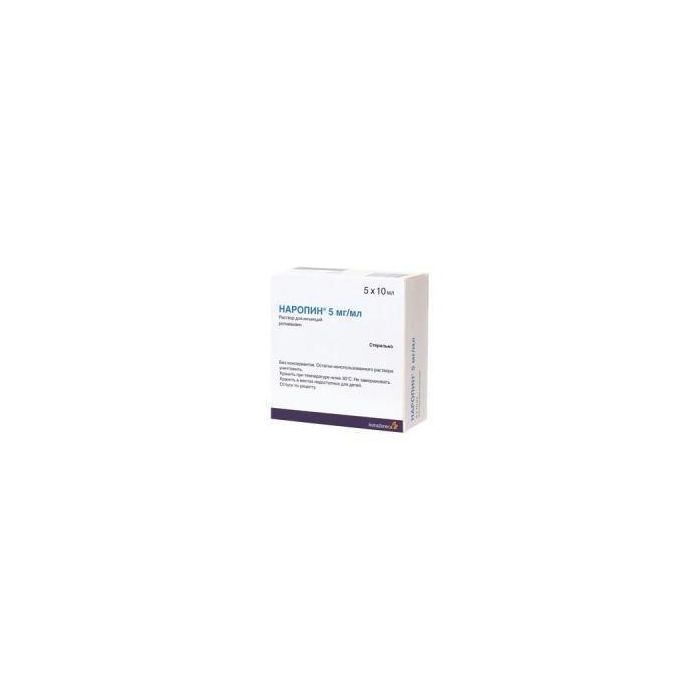Ropyvakayn | Naropin solution for injection 5 mg / ml ampoules of polypropi
Special Price
$69
Regular Price
$81
In stock
SKU
BID464768
Release form
Injection.
Packing
5 ampoules of 10 ml.
Pharmacological action
Naropine is the first local long-acting amide type anesthetic that is a pure enantiomer. It has both anesthetic and analgesic effects.
High doses of the drug are used for local anesthesia during surgical interventions, low doses of the drug provide analgesia (sensory block) with a minimal and non-progressive motor block.
Adrenaline supplementation does not affect the duration and intensity of the blockade caused by ropivacaine. By reversibly blocking voltage-dependent sodium channels, it prevents the generation of impulses at the ends of sensory nerves and the conduction of impulses along nerve fibers.
Like other local anesthetics, it can affect other excitable cell membranes (for example, in the brain and myocardium). If an excess of local anesthetic reaches the systemic circulation in a short period of time, signs of systemic toxicity may occur.
Signs of toxicity from the central nervous system precede signs of toxicity from the cardiovascular system, as they are observed at lower concentrations of the drug in plasma.
The direct effects of local anesthetics on the heart include slower conduction, a negative inotropic effect and, with severe overdose, arrhythmias and cardiac arrest. Intravenous administration of high doses of ropivacaine leads to the same effects on the heart.
Intravenous infusion of ropivacaine in healthy volunteers showed its good tolerance. Indirect cardiovascular effects (decreased blood pressure, bradycardia), which may occur after epidural administration of ropivacaine, are due to the occurrence of sympathetic blockade.
Indications
Local anesthesia: epidural, incl. with caesarean section,
conductor (including large nerves and plexuses),
infiltration,
relief of acute pain syndrome (including postoperative analgesia and labor analgesia).
Contraindications
hypersensitivity
children under 12 years of age (i.e. there are not enough clinical observations).
Use during pregnancy and lactation
Caution. The use for anesthesia or analgesia in obstetrics is justified.
Dosage and administration of
Naropine should only be used by specialists, with sufficient experience in conducting regional anesthesia, or under their supervision.
When selecting a dose of the drug should be based on clinical experience, taking into account the physical status of the patient.
In general, anesthesia during surgical interventions (for example, during epidural administration) requires higher doses and more concentrated solutions of the drug.
For pain relief (e.g. epidural administration to relieve pain), lower doses and concentrations are recommended.
Side effects
Adverse reactions to Naropine are similar to reactions to other local amide type anesthetics. They should be distinguished from physiological effects, arising due to blockade of the sympathetic nerves against the background of epidural anesthesia, such as a decrease in blood pressure, bradycardia, or effects related to the administration technique, such as local nerve damage, meningitis, post-puncture headache, epidural abscess.
Side effects of local anesthetics
From the central and peripheral nervous system
Neuropathy and impaired spinal cord function (anterior spinal artery syndrome, arachnoiditis, horse tail syndrome) are possible, usually associated with regional anesthesia technique, and not with the effect of the drug.
As a result of accidental intrathecal administration of an epidural dose, a complete spinal block may occur.
Serious complications are possible with systemic overdose and inadvertent intravascular administration of the drug (see section "Overdose").
Acute systemic toxicity
Naropine can cause acute systemic toxic reactions when using high doses or when its concentration in the blood rises rapidly in case of accidental intravascular injection or overdose (see section "Overdose").
The most common side effects of
Various side effects of the drug have been reported, the vast majority of which were associated not with the effects of the anesthetic used, but with regional anesthesia techniques.
Most often (> 1%) the following side effects were noted, which were regarded as of clinical importance, regardless of whether a causal relationship was established using an anesthetic: decreased blood pressure *, nausea, bradycardia, vomiting, paresthesia, fever, headache, urinary retention, dizziness, chills, increased blood pressure, tachycardia, hypesthesia, anxiety.
Very often
From the CCC: lowering blood pressure.
From the gastrointestinal tract: nausea.
Often
From the nervous system: paresthesia, dizziness, headache.
From the CCC side: bradycardia, tachycardia, hypertension.
From the digestive tract: vomiting.
From the genitourinary system: urinary retention.
General: back pain, chills, fever.
Infrequently
From the nervous system: anxiety, symptoms of toxicity from the central nervous system (convulsions, large seizures, paresthesias in the near-mouth zone, dysarthria, numbness of the tongue, visual impairment, ringing in the ears, tremors, muscle cramps), hypesthesia.
From the vascular system: fainting.
From the respiratory system: shortness of breath, shortness of breath.
General: hypothermia.
Rarely
From the CCC side: arrhythmia, cardiac arrest.
General: allergic reactions (anaphylactic reactions, angioedema, urticaria).
Drug Interaction
Increases the toxic effects of other local anesthetics and drugs, in a structure similar to local amide-type anesthetics.
Overdose
Symptoms: disorders of vision and hearing, hypotension, arrhythmia, dysarthria, increased muscle tone, muscle twitches, convulsions, loss of consciousness, hypoxia, hypercapnia, respiratory failure or arrest.
Treatment: discontinuation of the drug, maintenance of adequate oxygenation, relief of convulsions and convulsions (in thiopental 100-120 mg or diazepam 5-10 mg), normalization of blood circulation, correction of acidosis in the development of hypotension and bradycardia - in / in 10 mg of ephedrine (possibly repeated in 2-3 minutes).
Storage conditions
At a temperature below 30 РC (do not freeze)
Expiration
3 years.
Active ingredient
Ropivacaine
Dosage form
dosage form
for injection
AstraZeneca, Britain
Submit your review to Earn 10 Reward Points click here to login
Write Your Own Review

